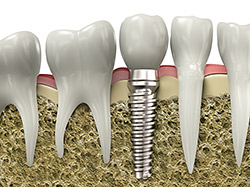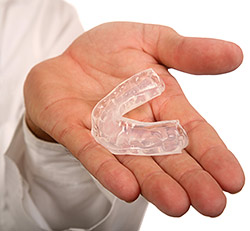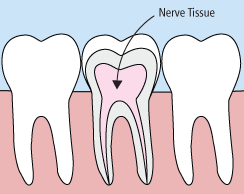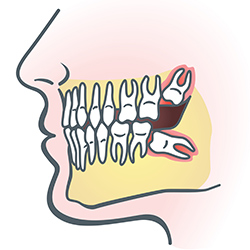Common Procedures
Topics on this page

Periodic preventive exams and cleanings
Visiting our office at your recommended maintenance intervals not only ensures your long-term dental health, but gives you the chance to ask your hygienist and Dr. Herre any questions you may have about your oral health.
Your periodic preventive exam and cleaning will take approximately one hour. During this visit your teeth will be thoroughly cleaned and polished, an oral cancer exam will be completed, your periodontal health will be assessed and any necessary radiographs taken.
Bonding
 Bonding is a conservative way to repair slightly chipped, discolored, or crooked teeth. During dental bonding, a tooth colored restorative material is placed onto your tooth to improve its appearance. The restorative material bonds onto your teeth. Because it comes in a variety of tooth-colored shades, it closely matches the appearance of your natural teeth.
Bonding is a conservative way to repair slightly chipped, discolored, or crooked teeth. During dental bonding, a tooth colored restorative material is placed onto your tooth to improve its appearance. The restorative material bonds onto your teeth. Because it comes in a variety of tooth-colored shades, it closely matches the appearance of your natural teeth.
Tooth bonding can also be used for traditional fillings instead of amalgam. Many patients prefer bonded restorations because the actual color is much less noticeable than the silver amalgam. Bonding restorations can be used on front or back teeth, depending on the location and extent of tooth decay.
Bonding is less expensive than other cosmetic treatments and can usually be completed in one visit to our office. However, it can stain over time and is easier to break than other cosmetic treatments, such as porcelain veneers. If it does break or chip, let us know. The bonding can generally be easily corrected or repaired in one visit.
Bridges
 A bridge may be used to replace one or more missing teeth, or act to strengthen weaker teeth by giving them additional support.
A bridge may be used to replace one or more missing teeth, or act to strengthen weaker teeth by giving them additional support.
A bridge replaces missing teeth with artificial teeth, looks great, and literally bridges the gap where one or more teeth may have been. Your bridge can be made from gold, alloys, porcelain, or a combination of these materials and is cemented onto surrounding teeth for support.
The success of any bridge depends on its foundation — the other teeth, gums, or bone to which it is attached. Therefore, it’s very important to keep your existing teeth, gums, and jaw healthy and strong.
Crowns
 Crowns are restorative procedures used to strengthen the integrity of a tooth or correct its shape and function. Crowns are most often used for teeth that are broken, worn, or have portions destroyed by tooth decay.
Crowns are restorative procedures used to strengthen the integrity of a tooth or correct its shape and function. Crowns are most often used for teeth that are broken, worn, or have portions destroyed by tooth decay.
A crown is a restoration cemented onto an existing tooth that usually covers the portion of your tooth above the gum line. In effect, the crown becomes your tooth’s new outer surface. Crowns can be made of porcelain, metal, or both. Porcelain crowns are most often preferred because they mimic the translucency of natural teeth and are very strong.
Crowns or onlays (partial crowns) are needed when there is insufficient tooth strength to hold a filling. Unlike fillings, which apply the restorative material directly into your mouth, a crown is fabricated away from your mouth.
Your crown is created in a lab from your unique tooth impression, which allows a dental laboratory technician to examine all aspects of your bite and jaw movements. Your crown is then sculpted just for you so your bite and jaw movements function normally once the crown is placed.
Dentures
 Dentures are natural-looking replacement teeth that are removable. There are two types of dentures: full and partial. Full dentures are given to patients when all the natural teeth have been removed. Partial dentures are attached to a metal frame connected to your natural teeth and are used to fill in where permanent teeth have been removed.
Dentures are natural-looking replacement teeth that are removable. There are two types of dentures: full and partial. Full dentures are given to patients when all the natural teeth have been removed. Partial dentures are attached to a metal frame connected to your natural teeth and are used to fill in where permanent teeth have been removed.
Just like natural teeth, dentures need to be properly cared for. Use a gentle cleanser to brush your dentures, always keep them moist when they’re not in use, and be sure to keep your tongue and gums clean as well.
Extractions
 There are times when it is necessary to remove a tooth. Sometimes a baby tooth has misshapen or long roots that prevent it from falling out as it should, and the tooth must be removed to make way for the permanent tooth to erupt. At other times, a tooth may have so much decay that it puts the surrounding teeth at risk, so Dr. Herre may recommend removal and replacement with a bridge or implant. Infection, orthodontic correction, or problems with a wisdom tooth can also require removal of a tooth.
There are times when it is necessary to remove a tooth. Sometimes a baby tooth has misshapen or long roots that prevent it from falling out as it should, and the tooth must be removed to make way for the permanent tooth to erupt. At other times, a tooth may have so much decay that it puts the surrounding teeth at risk, so Dr. Herre may recommend removal and replacement with a bridge or implant. Infection, orthodontic correction, or problems with a wisdom tooth can also require removal of a tooth.
The root of each tooth is encased within your jawbone in a “tooth socket,” and your tooth is held in that socket by a ligament. In order to extract a tooth, a dentist must expand the socket and separate the tooth from the ligament holding it in place. When it is determined that a tooth needs to be removed, Dr. Herre will either proceed with its removal or, for more complex cases, refer you to a specialist known as an oral surgeon.
Once a tooth has been removed, neighboring teeth may shift, causing problems with chewing or with your jaw joint function. To avoid these complications, Dr. Herre may recommend you replace the extracted tooth.
Fillings
 Traditional dental restorations, or fillings, may include gold, porcelain, or composite. Newer dental restorations include ceramic and high-strength composites that mimic the appearance of natural teeth. These very aesthetically appealing new materials were originally created for the front teeth, but now have the strength to also be used on the back teeth as well.
Traditional dental restorations, or fillings, may include gold, porcelain, or composite. Newer dental restorations include ceramic and high-strength composites that mimic the appearance of natural teeth. These very aesthetically appealing new materials were originally created for the front teeth, but now have the strength to also be used on the back teeth as well.
There are two different kinds of restorations: direct and indirect. Direct restorations are placed into a prepared tooth during a single visit. Indirect restorations generally require two or more visits. These restorations include inlays, and veneers fabricated with ceramics or composites.
Implant restoration
 If you are missing teeth, it is crucial to replace them. Without all your teeth, chewing and eating can destabilize your bite and cause you discomfort. When teeth are missing, your mouth can shift and even cause your face to look older. Implants are a great way to replace your missing teeth, and if properly maintained, can last a lifetime!
If you are missing teeth, it is crucial to replace them. Without all your teeth, chewing and eating can destabilize your bite and cause you discomfort. When teeth are missing, your mouth can shift and even cause your face to look older. Implants are a great way to replace your missing teeth, and if properly maintained, can last a lifetime!
An implant is a new tooth made of metal and porcelain that looks just like your natural tooth. It’s composed of two main parts: One is the titanium implant body that takes the place of the missing root, and the other is the tooth-colored crown that is cemented on top of the implant. With implant treatment, you can smile confidently, knowing no one will ever suspect you have a replacement tooth.
In addition to tooth replacement, implants may be used to anchor dentures, especially lower dentures that tend to shift when you talk or chew. For patients with removable partial dentures, implants can replace missing teeth, so you have a more natural-looking smile.
Fluoride
 Fluoride is effective in preventing cavities and tooth decay. It also prevents plaque from building up and hardening on the tooth’s surface. A fluoride treatment in your dentist’s office takes just a few minutes. After the treatment, patients may be asked not to rinse, eat, or drink for at least 30 minutes in order to allow the teeth to absorb the fluoride. Fluoride treatments are very important for children on a regular basis, because they are more prone to decay.
Fluoride is effective in preventing cavities and tooth decay. It also prevents plaque from building up and hardening on the tooth’s surface. A fluoride treatment in your dentist’s office takes just a few minutes. After the treatment, patients may be asked not to rinse, eat, or drink for at least 30 minutes in order to allow the teeth to absorb the fluoride. Fluoride treatments are very important for children on a regular basis, because they are more prone to decay.
Athletic Mouthguards
 Whether you wear braces or not, protecting your smile while playing sports is essential. Mouthguards help protect your teeth and gums from injury. If you participate in any kind of full-contact sport, the American Dental Association recommends that you wear a mouthguard.
Whether you wear braces or not, protecting your smile while playing sports is essential. Mouthguards help protect your teeth and gums from injury. If you participate in any kind of full-contact sport, the American Dental Association recommends that you wear a mouthguard.
Choosing the right mouthguard is essential. There are three basic types of mouthguards: the pre-made mouthguard, the “boil-and-bite” fitted mouthguard, and a custom-made mouthguard from your dentist. When you choose a mouthguard, be sure to pick one that is tear-resistant, comfortable and well-fitted for your mouth, easy to keep clean, and does not prevent you from breathing properly.
Dr. Herre can show you how to wear a mouthguard properly and how to choose the right mouthguard to protect your teeth.
Bruxism Splints
 If you often wake up with jaw pain, earaches, or headaches, or you find yourself clenching or grinding your teeth, you may have a common condition called “bruxism.” Many people do not even know they grind their teeth, because it often occurs during sleep. If not corrected, bruxism can lead to severe tooth wear, cracked teeth, or even tooth loss.
If you often wake up with jaw pain, earaches, or headaches, or you find yourself clenching or grinding your teeth, you may have a common condition called “bruxism.” Many people do not even know they grind their teeth, because it often occurs during sleep. If not corrected, bruxism can lead to severe tooth wear, cracked teeth, or even tooth loss.
There is a simple, non-invasive treatment for bruxism: bruxism splints. Bruxism splints are an easy way to prevent the wear and damage that teeth-grinding causes over time. Custom-made by a dentist from hard acrylic to fit your teeth exactly, a splint is inserted over your top teeth and prevents contact with the opposing teeth.
Root canals
 In the past, if you had a tooth with a diseased nerve, you’d probably lose that tooth. Today, with a special dental procedure called “root canal treatment,” your tooth can be saved. When a tooth is cracked or has a deep cavity, bacteria can enter the pulp tissue and germs can cause an infection inside. If left untreated, an abscess may form. If the infected tissue is not removed, pain and swelling can result. This can not only injure your jawbones, but it is also detrimental to your overall health.
In the past, if you had a tooth with a diseased nerve, you’d probably lose that tooth. Today, with a special dental procedure called “root canal treatment,” your tooth can be saved. When a tooth is cracked or has a deep cavity, bacteria can enter the pulp tissue and germs can cause an infection inside. If left untreated, an abscess may form. If the infected tissue is not removed, pain and swelling can result. This can not only injure your jawbones, but it is also detrimental to your overall health.
If a rooth canal is warranted, Dr. Herre will refer you to a specialist called an endodontist.
Root canal treatment involves one to three visits. During treatment the affected tissue is removed. Next, the interior of the tooth will be cleaned and sealed. Finally, the tooth is filled with a dental composite.
If your tooth has extensive decay you may need a crown to strengthen and protect it from breaking. As long as you continue to care for your teeth and gum tissue with regular brushing, flossing, and checkups, your restored tooth can last a lifetime.
Sealants
 Sometimes brushing is not enough, especially when it comes to those hard-to-reach spots in your mouth. It is difficult for your toothbrush to get between the small cracks and grooves on your teeth. If left alone, those tiny areas can develop tooth decay. Sealants give your teeth extra protection against decay and help prevent cavities.
Sometimes brushing is not enough, especially when it comes to those hard-to-reach spots in your mouth. It is difficult for your toothbrush to get between the small cracks and grooves on your teeth. If left alone, those tiny areas can develop tooth decay. Sealants give your teeth extra protection against decay and help prevent cavities.
Dental sealants are plastic resins that bond and harden in the deep grooves on your tooth’s surface. When a tooth is sealed, the tiny grooves become smooth and are less likely to harbor plaque. With sealants, brushing your teeth becomes easier and more effective against tooth decay.
Sealants are typically applied to children’s teeth as a preventive measure against tooth decay after the permanent teeth have erupted. However, adults can also receive sealants on healthy teeth. It is more common to seal “permanent” teeth rather than “baby” teeth, but every patient has unique needs, and your dentist will recommend sealants on a case-by-case basis.
Porcelain Veneers
 You no longer need to hide your smile because of gaps, chips, stains, or misshapen teeth. With porcelain veneers, you can easily correct your teeth’s imperfections to help you have a more confident, beautiful smile. Veneers are natural in appearance, and they are a perfect option for patients wanting to make minor adjustments to the look and feel of their smile.
You no longer need to hide your smile because of gaps, chips, stains, or misshapen teeth. With porcelain veneers, you can easily correct your teeth’s imperfections to help you have a more confident, beautiful smile. Veneers are natural in appearance, and they are a perfect option for patients wanting to make minor adjustments to the look and feel of their smile.
Porcelain veneers are thin, custom-made shells made from tooth-colored materials, such as porcelain. They are designed to cover the front side of your teeth. To prepare for veneers, Dr. Herre will create a unique model of your teeth. This model is sent to the dental technician to create your veneers. Before placing your new veneer, he may need to prepare your tooth conservatively to achieve the desired aesthetic result. When your veneers are in place, you”ll be pleased to see that they look like your natural teeth.
Wisdom teeth
 Wisdom teeth are the last molars found in the very back of your mouth. They usually appear in the late teens or early twenties, but may become impacted (fail to erupt) due to lack of room in the jaw or angle of entry. When a wisdom tooth is impacted, it may need to be removed.
Wisdom teeth are the last molars found in the very back of your mouth. They usually appear in the late teens or early twenties, but may become impacted (fail to erupt) due to lack of room in the jaw or angle of entry. When a wisdom tooth is impacted, it may need to be removed.
If it is not removed, you may develop gum tenderness, swelling, or even severe pain. Impacted wisdom teeth that are partially or fully erupted tend to be quite difficult to clean and are susceptible to tooth decay, recurring infections, and even gum disease.
Wisdom teeth are typically removed in the late teens or early twenties because there is a greater chance that the roots have not fully formed and the bone surrounding the teeth is less dense. These two factors can make extraction easier as well as shorten the recovery time.
Dr. Herre will be evaluating these teeth at each regular dental visit as children progress through adolescence into their teens. Determining the need for, and timing of, wisdom teeth extractions is critical.

